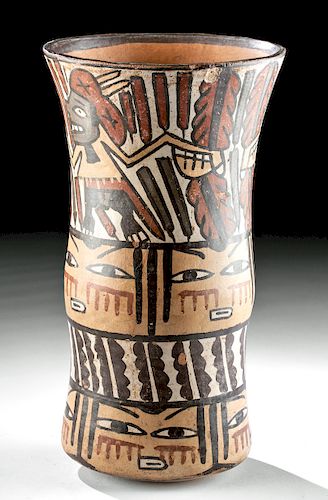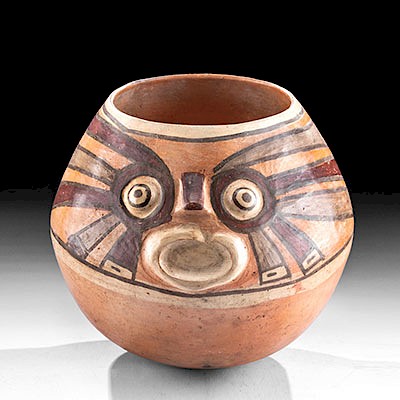Nazca Polychrome Cylinder Vessel with Running Warriors
Lot 107
About Seller
Artemis Fine Arts
686 S Taylor Ave, Ste 106
Louisville, CO 80027
United States
Selling antiquities, ancient and ethnographic art online since 1993, Artemis Gallery specializes in Classical Antiquities (Egyptian, Greek, Roman, Near Eastern), Asian, Pre-Columbian, African / Tribal / Oceanographic art. Our extensive inventory includes pottery, stone, metal, wood, glass and textil...Read more
Estimate:
$1,800 - $2,700
Absentee vs Live bid
Two ways to bid:
- Leave a max absentee bid and the platform will bid on your behalf up to your maximum bid during the live auction.
- Bid live during the auction and your bids will be submitted real-time to the auctioneer.
Bid Increments
| Price | Bid Increment |
|---|---|
| $0 | $25 |
| $300 | $50 |
| $1,000 | $100 |
| $2,000 | $250 |
| $5,000 | $500 |
| $10,000 | $1,000 |
| $20,000 | $2,500 |
| $50,000 | $5,000 |
| $100,000 | $10,000 |
| $200,000 | $20,000 |
About Auction
By Artemis Fine Arts
Dec 5, 2019
Set Reminder
2019-12-05 10:00:00
2019-12-05 10:00:00
America/New_York
Bidsquare
Bidsquare : Ancient / Ethnographic - Holiday Edition
https://www.bidsquare.com/auctions/artemis-gallery/ancient-ethnographic---holiday-edition-4710
What to give this holiday season? Ancient & Ethnographic Art of course! Our special Holiday auction features hundreds of unique finds from all over the world. Artemis Fine Arts info@artemisfinearts.com
What to give this holiday season? Ancient & Ethnographic Art of course! Our special Holiday auction features hundreds of unique finds from all over the world. Artemis Fine Arts info@artemisfinearts.com
- Lot Description
Pre-Columbian, Peru (south coast), probably Middle Nazca, Phase 5, ca. 450 to 550 CE. A striking kero (quero), a ceramic vessel with a tall body and flaring mouth. This example has a rare form: rather than gradually widening from the flat base to the mouth, the body undulates so that it bows out at the center as well as the mouth. It is painted in the distinctive features four bands of decoration: two feature repeated disembodied faces, referencing trophy heads, that face outward and have red linear motifs on their cheeks that may represent tattoos - or bloody cuts. Above the bottom band of these faces is a band of feathered arrow ends; above the central band of faces is a complex repeated motif of warriors running between falling arrows. Size: 4.05" W x 7.5" H (10.3 cm x 19 cm)
This kero would have been used to give an offering of chicha (corn beer) in a grave, where the vast majority of known Nazca pottery has been found. In ancient Peru, corn was not the staple food stuff that it was in Mesoamerica; instead, it seems to have mainly been used to make chicha and, possibly, a stronger hallucinogenic brew when combined with cactus juice. The Nazca linked trophy heads with corn - sometimes even portraying exposed ears of corn as trophy heads - because they believed that the taking of heads provided the necessary supernatural power to allow agricultural crops to grow.
Provenance: ex-private Hans Juergen Westermann collection, Germany, collected in 1950 to the 1960s
All items legal to buy/sell under U.S. Statute covering cultural patrimony Code 2600, CHAPTER 14, and are guaranteed to be as described or your money back.
A Certificate of Authenticity will accompany all winning bids.
We ship worldwide and handle all shipping in-house for your convenience.
#150544A long fissure down one side has been expertly repaired and restored. This is well done and almost impossible to discern. Otherwise in very nice condition with excellent remaining pigment and very light deposits.Condition
- Shipping Info
-
All shipping is handled in-house for your convenience. Your invoice from Artemis Gallery will include shipping calculation instructions. If in doubt, please inquire BEFORE bidding for estimated shipping costs for individual items.
-
- Buyer's Premium



 EUR
EUR CAD
CAD AUD
AUD GBP
GBP MXN
MXN HKD
HKD CNY
CNY MYR
MYR SEK
SEK SGD
SGD CHF
CHF THB
THB















